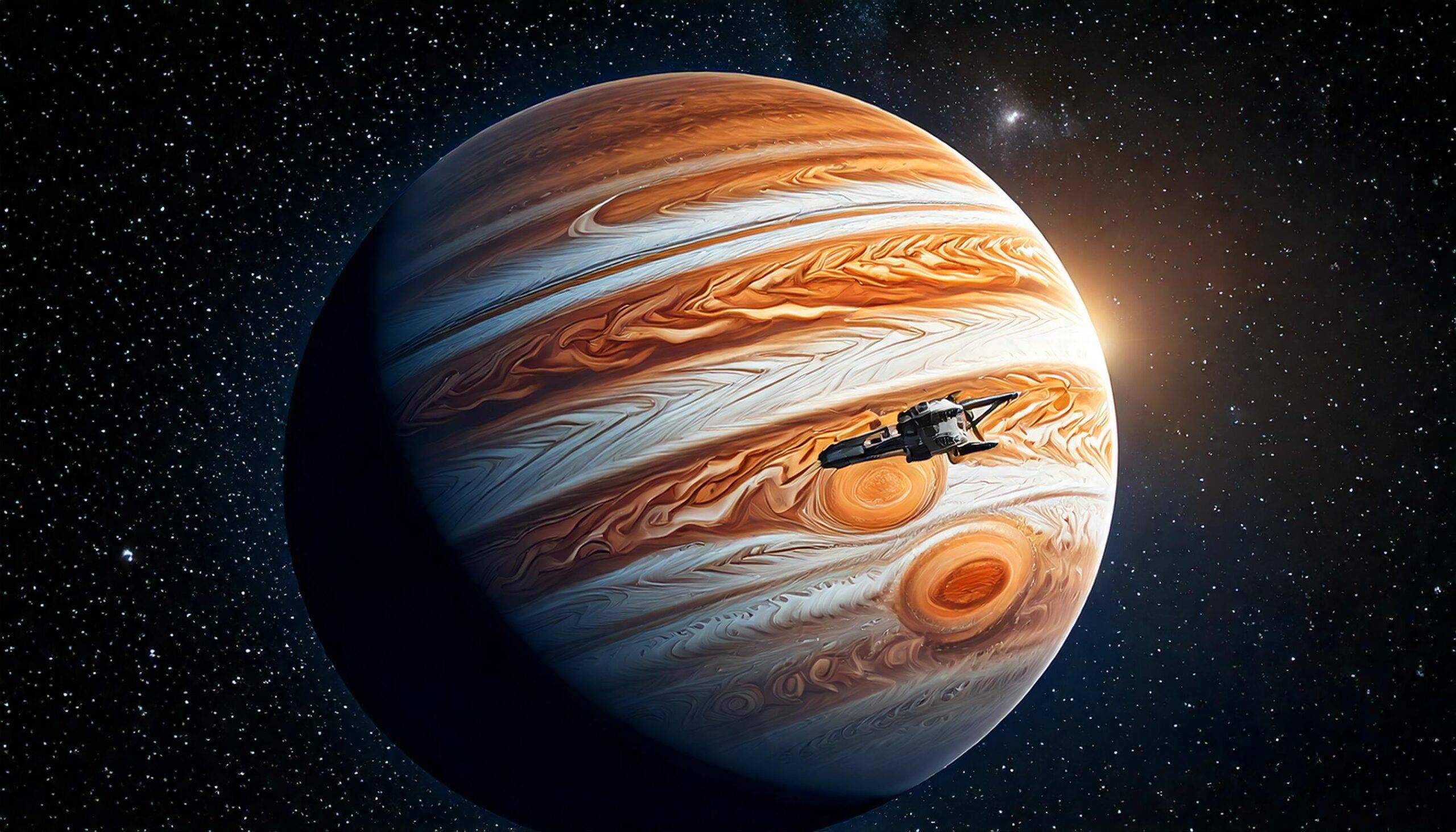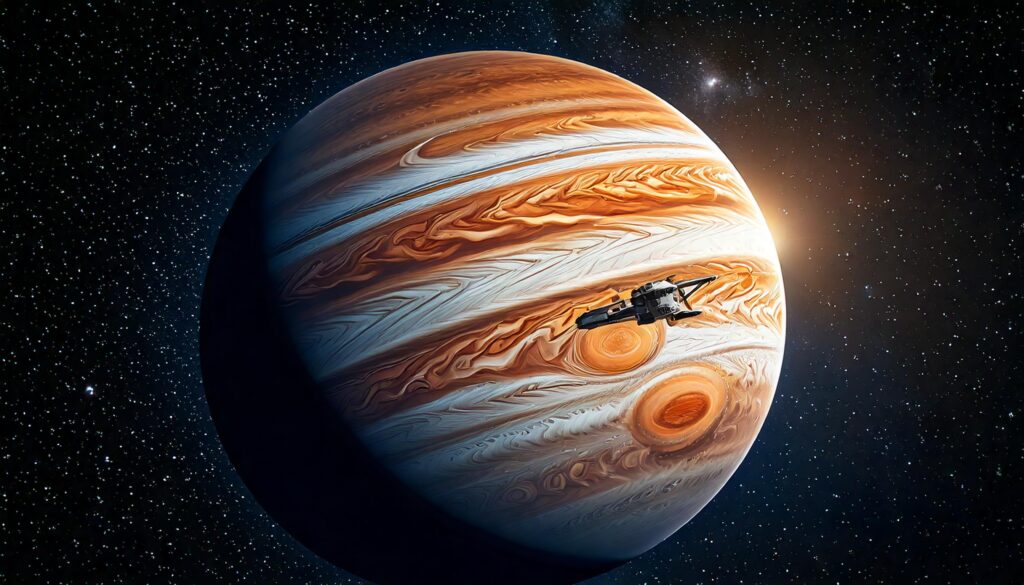
Engage Students in Planetary Science with AR & AI: Jupiter Exploration Project
Oct 29, 2024

The “Jupiter Exploration with AR & AI” project offers teachers a simple yet impactful way to introduce students to the fascinating world of Jupiter, right from their classroom. With just a Windows or Mac computer equipped with a webcam, teachers can bring this experience to life on a connected projector, TV, or smart board. Designed to be easy to use and integrate, this AR-based project immerses students in Jupiter’s unique features—its massive storms, powerful gravity, and its system of 79 moons—making abstract science concepts tangible and engaging. It is free for teachers to use in the classroom.
This free resource is structured to align with NGSS standards and includes interactive stages that encourage hands-on learning and critical thinking. Each lesson offers a guided exploration of Jupiter’s environment, supported by visual AR effects and interactive AI prompts that spark student curiosity. With this tool, teachers can foster a deeper understanding of space science while keeping students actively engaged and excited about learning. Read on for a full guide on how to bring Jupiter’s wonders to your classroom with this accessible, enriching project.
Instruction Guide
Introduction to the Project:
- Stage 1: Meet Jupiter - Introduce Jupiter as the largest planet in our solar system, highlighting its massive size, gas composition, and strong gravity.
- Stage 2: The Great Red Spot and Cloud Patterns - Explore Jupiter’s unique features, including the Great Red Spot, a centuries-old storm, and its colorful cloud patterns, known as the Stripes.
- Stage 3: Jupiter’s Moons - Discuss Jupiter's 79 moons and explain how its strong gravity captures and holds these celestial bodies in orbit.
- Stage 4: Gravity on Jupiter - Experience Jupiter’s powerful gravity, comparing it to Earth’s and observing how objects would fall faster due to its strong gravitational pull.
- Stage 5: Reflection and Review - Summarize Jupiter's characteristics, emphasizing its size, Great Red Spot, moons, and gravitational force, and encourage further curiosity about space.
Each stage integrates narration and interactive AI activities to encourage critical thinking and hands-on engagement with Jupiter's features.
Learning Objectives and Outcomes
Learning Objectives with NGSS Standards Alignment:
- Understand Jupiter’s Position, Size, and Composition
- Objective: Students will learn that Jupiter is the largest planet in the solar system, mainly composed of gas, and has a gravitational pull much stronger than Earth’s.
- NGSS Alignment: ESS1.B: Earth and the Solar System - Explore differences in planetary size, composition, and gravitational strength.
- NGSS Code: 5-ESS1-2 - Represent data to show patterns in planetary characteristics, comparing Jupiter to Earth.
- Explore Jupiter's Atmospheric Patterns and the Great Red Spot
- Objective: Students will observe Jupiter’s atmospheric features, including the Great Red Spot and the Stripes, and understand how these patterns reflect Jupiter’s stormy weather systems.
- NGSS Alignment: ESS1.B: Earth and the Solar System - Examine unique atmospheric features on planets.
- NGSS Code: 5-ESS1-2 - Use patterns to understand planetary characteristics.
- Discover How Jupiter's Gravity Influences Its Moons
- Objective: Students will learn how Jupiter’s strong gravity captures moons and space objects, resulting in 79 moons.
- NGSS Alignment: PS2.A: Forces and Motion - Explore the effects of gravitational force on celestial bodies.
- NGSS Code: 5-PS2-1 - Describe gravitational force in relation to planetary objects.
- Investigate the Effects of Gravity on Motion
- Objective: Students will experience Jupiter’s powerful gravity, observing how it affects the speed of falling objects and comparing it to Earth’s gravity.
- NGSS Alignment: PS2.A: Forces and Motion - Understand how different gravitational strengths influence motion.
- NGSS Code: 5-PS2-1 - Explain the effects of gravitational pull.
Learning Outcomes:
- Outcome 1: Students can describe Jupiter’s characteristics, including its size, gas composition, and gravity.
- Outcome 2: Students can explain Jupiter’s unique atmospheric patterns and the effects of gravity on its many moons.
- Outcome 3: Students apply scientific vocabulary, aligned with NGSS and Common Core standards, to describe Jupiter’s environmental and gravitational features.
Classroom Activity Design
Pre-AR Project Activities (Warm-Up & Background Building)
- Planetary Size Comparison Warm-Up
- Objective: Help students grasp the scale of Jupiter compared to Earth.
- Activity: Use visuals or a size comparison chart to show that 1,300 Earths could fit inside Jupiter. Discuss what makes Jupiter a "gas giant."
- Outcome: Provides context for Jupiter’s massive size and prepares students to understand its strong gravity.
- Atmospheric Patterns and Storms
- Objective: Introduce the concept of atmospheric storms, comparing Jupiter’s Great Red Spot to storms on Earth.
- Activity: Show a short video of hurricanes or storms on Earth, then ask students to imagine a storm twice as large as Earth lasting over 300 years.
- Outcome: Prepares students to understand the scale and intensity of Jupiter’s Great Red Spot.
Holographic AR Project: Jupiter Exploration with AR & AI
- Guided Experience: Students explore Jupiter’s size, the Great Red Spot, atmospheric Stripes, moons, and gravity through interactive AR and AI narration.
- AI Interaction: Students answer prompts about Jupiter’s unique features, its strong gravity, and its many moons, observing how each aspect makes Jupiter distinct.
Post-AR Project Activities (Reinforcement & Hands-On Learning)
- Jupiter’s Key Features Discussion
- Objective: Reinforce main concepts learned about Jupiter.
- Activity: In small groups, students discuss key facts about Jupiter’s size, storms, gravity, and moons. Each group presents one fact they found surprising.
- Outcome: Helps students summarize the main points of the AR experience and reinforces comprehension through collaborative learning.
- Gravity Simulation (Hands-On)
- Objective: Demonstrate Jupiter’s stronger gravity and how it affects falling objects.
- Activity: Using weighted objects, drop them from the same height to show the effect of strong gravity on speed. Discuss how much more they would weigh on Jupiter.
- Outcome: Tangibly illustrates the impact of Jupiter’s gravity, linking it to what students observed in the AR experience.
- Create a Model of Jupiter’s Moons
- Objective: Help students visualize Jupiter’s gravitational pull and its ability to hold 79 moons.
- Activity: Students create a 3D model with a large sphere for Jupiter and smaller spheres for moons. Arrange the moons to simulate Jupiter’s orbiting gravitational pull.
- Outcome: Reinforces understanding of gravitational influence and the scale of Jupiter’s moon system.
Classroom Management Tips
- Clear Viewing: Arrange seating to ensure all students can clearly view the AR project screen, fostering a focused, engaging environment.
- Rotate Participation: Assign students different roles or prompts during the AR stages to ensure everyone has a chance to participate actively.
- Encourage Prepared Responses: Before beginning, help students prepare responses for AI questions to boost confidence and facilitate engagement.
- Inclusive Participation: Be attentive to quieter students, encouraging them to participate by assigning roles or prompting responses.
- Praise and Recognition: Give positive feedback for each student’s participation, promoting a supportive learning environment.
- Manage Turn-Taking: Monitor participation to ensure fair access, especially for hands-on activities. Gently remind enthusiastic students to allow others a chance to engage.
Formative Assessments
- Quick Facts Check: After each stage, ask students to share one thing they learned, such as why Jupiter is called a "gas giant" or what the Great Red Spot is.
- Reflection Journal: Students write a brief journal entry summarizing what they found most interesting about Jupiter. Example prompts:
- “Describe one unique thing about Jupiter.”
- “What surprised you about Jupiter’s gravity or moons?”
- Jupiter and Earth Comparison Worksheet
- What It Is: A worksheet where students compare Jupiter and Earth based on size, composition, gravity, and number of moons.
- Purpose: Reinforces understanding of Jupiter’s features by contrasting it with Earth, making planetary differences clear.
- Gravity Simulation Reflection
- What It Is: After the gravity simulation, ask students to describe how Jupiter’s gravity affects falling objects and their weight.
- Purpose: Reinforces understanding of gravitational strength on Jupiter and its effects on motion.
Cross-Subject Integration Suggestions
- Math: Calculate the weight difference between Earth and Jupiter, using a simple multiplication for Jupiter’s 2.5x stronger gravity.
- Art: Have students draw Jupiter with its Great Red Spot and colorful Stripes, adding details that reflect its unique features.
- Language Arts: Write a paragraph describing what it would be like to stand on Jupiter, incorporating vocabulary like “gas giant,” “gravity,” and “moon.”
- History/Social Studies: Discuss the history of exploring Jupiter through missions like Voyager and Juno, exploring how scientists study distant planets.

